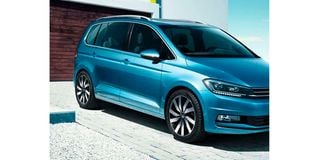All about 7-seaters and SUVs, plus the Volkswagen Touran 1400cc

Volkswagen Touran.
What you need to know:
- I cannot decisively recommend (nor condemn) a vehicle I have not at least driven for some distance.
- VW’s track record is one of the foundation stones of Germany’s reputation for engineering excellence.
Hi, what’s your take on the Volkswagen Touran 1400cc 7 seater? Any comment on the Honda Insight? While at it, please compare the Honda CRV, Subaru Forester and Mazda CX5. Also, which seven seater or SUV would you recommend?
I cannot decisively recommend (nor condemn) a vehicle I have not at least driven for some distance, and preferably “lived with” (owned). Any opinion without that hands-on experience is hearsay…or extrapolation.
Using the last of those options, some thoughts spring to mind: that VW is one of the largest, most renowned and longest standing motor companies in the world (it celebrates the 90th anniversary of its origins this year). Some of its models have achieved world record sales (the Beetle, the Kombi, the Golf…which I have owned). VW’s track record is one of the foundation stones of Germany’s reputation for engineering excellence.
Although its most successful models have been small and relatively basic, the VW Group does now also embrace Bentley, Lamborghini and Bugatti (well-known shopping cars in places like Monaco and St Moritz) and a long list of other quite famous brands born in Germany, Spain, Czechoslovakia and Italy.

Volkswagen Touran.
On hearsay, during VW’s more recent expansion in to the larger and more luxurious/sophisticated car market, it does sound as though they have had a share of teething gremlins, and you may remember that their emissions data has sometimes been less than certain.
The technical specifications of the Touran are what you might expect and its engine is the same as the 1.4 used on at least a dozen other models.
Big job for small engine
However, a 1.4 litre engine in a 7-seater does sound a bit like trying to get a gallon out of a pint pot. The vehicle itself weighs nearly 1.5 tonnes, and with seven people and their luggage, the all-up weight could be nearer 2.5 tonnes. The selected engine size suggests it is intended primarily for spacious but economical in-town use for activities like school runs, shopping and airport shuttle services.
That does not mean it cannot do long-haul cruises. With just a driver and a heavy right foot, it can (theoretically) accelerate to 100 kilometers per hour in about 9 seconds and (theoretically) reach 200 kilometers per hour, but that is not what it would be best suited for nor best at.
Presuming the 1.4 litre engine is turbocharged, it will deliver the same power as a 2.2 litre naturally aspirated engine (in motorsport classification the conversion coefficient is x 1.7), though in ordinary use that will vary a bit according to boost pressure designs and adjustments.
But to deliver that much power (or cope with a 7-seater load) a small unit will have to work hard under considerable stress, which is not usually the best recipe for reliability and durability. You’ll find more details on that in my answer to another question (on truck engines) further below.
On recommendations, there is no modern vehicle that is better or worse at everything than any another make/model in the same class. In many respects, all of them are much the same, and each has some good and some weak points either side of the general norm.
Drivers are also ‘variants’
Which one will suit you best depends on which points are most important to you - considering where and how you motor and what you require the vehicle to do in your personal motoring patterns. The differences in owners is as important as the differences in makes and models. Those points could be space or power or comfort or price or durability or running economy or resale value, or spares availability, or just looks or image, and, by no means least, your “emotional” view of the brand and/or its agents.
If there was a universally “better” vehicle, all you would need to do is look around. All the cars of a particular class would be the same make and model. Clearly they are not.
The advantage of choosing the most popular brands is that spares and service expertise are likely to be more widely available, and resale demand and prices are likely to be higher.
The happy answer to the Honda CRV vs Subaru Forester vs Mazda CX-5 is that they are all good models of great brands with much in common in the norms area. Any would be great cars to own. List your own priorities and check the specs to see which is probably best for you. All will have more than a few variant options.
The Mazda Familia 323 might as well be a family pet…
I have a Mazda Familia 323, and its fuel consumption is rather too high. A litre goes for only 4 kilometers. The car does not smoke and the timing is okay and the engine has power. Kindly help me establish a solution to this problem. I have taken it for diagnosis several times but the problem is still there.
Anon
First, well done. The Mazda 323 is a legend for longevity, and in Europe, 323s have lived in the same driveway for so long that they are like beloved family pets. No wonder they were rebadged as the Familia.
I once owned one of the early 323s (I confiscated it from a company that didn’t take payment of my wages seriously enough 40 years ago), and have test driven its cousin brothers (the 929 and the 616) with great delight.
Second, if your 323’s engine starts easily, idles evenly, cruises smoothly, accelerates powerfully, doesn’t smoke and doesn’t make funny noises or smells, you would need to be driving up a very steep hill in first gear with your foot flat to the floorboards to consume a litre every 4 kilometers.

Mazda Familia.
The more likely problem is simply a leak somewhere between the fuel tank and the inlet manifold. Start your search at the front end, because it is probably leaking only when in use, not when standing still. That would also explain why, when it was checked in a garage, dripping fuel was not found. The leak may be very small, so the evidence evaporates in a hot engine compartment almost immediately.
In parallel (but not usually at this extreme) if an engine is running too rich a mixture (too much fuel or not enough air) the inside of the exhaust tailpipe will be black. It should be a medium grey colour, and after a long cruise at high speed, light grey.
Where has my oil gone?
I recently purchased a 2014 Subaru Outback, locally assembled. When I changed the engine oil, within a day it was warning of low engine oil and the dipstick showed half low oil mark. I had put synthetic oil, however, on draining it a week later, all 5 litres were drained and replaced with mineral oil rated for 5,000 km change intervals. Now, the same warning is showing with the engine oil dashboard sign. What could be the issue, and how can I resolve it?
Regards, Kiome
I once owned a very old Subaru Legacy estate which showed off its “engine” problem warning light all the time. The agents assured me it was a problem with the warning light, not the engine, and I could ignore it – which I did for many years without consequences.
The measure on the dipstick is an altogether different matter. And it has nothing to do with whether you use synthetic or mineral oil. So here’s what you need to check:
Drain the existing oil into a clean container. Measure the quantity. In a 4-cylinder 2014 Outback, it should be about 5 litres. Then (topped up if necessary to 5 litres) pour it back in through the oil filler cap, leaving a few minutes for the oil you pour in at the top to trickle down to the reservoir (sump) which the dipstick physically measures.
Check the reading on the dipstick. If it shows “full”, all is well. If it shows “half-low” as you say, check that the dipstick itself is the original and complete, and that it has been fully inserted.

A mechanic checks the engine oil
Drive the car for a while and then recheck the oil level on the dipstick. If the level of oil has gone down, drain and measure it. If the quantity of oil that comes out is the same as the quantity that you put in, then no oil has been “lost…so it has been “hiding” from the dipstick somewhere, somehow. Some of the oil you put in an engine clings to the inside of the engine itself and some is in the oil filter, but when you turn off the engine, the bulk always drains down into the sump, forming a “pond” in which the oil pump is submerged. When you restart the engine, the oil pump draws on that reserve and sprays it round everywhere. When you open the oil drain plug in the base of the sump, the whole pond flows out.
If the drained quantity is less than the fill quantity, then oil has been lost. If it has been burned in use, your exhaust will smoke. Otherwise there must be a leak.
PS: I do wonder who “locally assembled” your Outback. More about that in due course.
Everlasting truck engines
I am always amazed that truck engines clock hundreds of thousands, if not millions of kilometres, but not so with small diesel cars. I wonder how that is so, not forgetting that trucks are mostly heavily laden and may not be receiving as good care with maintenance and driving habits as cars. Why is that the case?
Best Regards,
Robert T
Be amazed no more. The differences might not be as great as you think, and where they do exist there is a good reason for them.
The engines of trucks are huge and heavy duty designed for the considerable workloads they will face. They are also relatively low revving, use different gearing, go further with each rotation of the wheels, are designed for maximum torque in the trade-off with horsepower, and in professionally managed transport companies, probably get much more attention than you realise, with service routines often daily or weekly to pre-empt problems rather than once every several months.
Many transporters have business disciplines which recognise that frequent and competent maintenance with quality parts is cheaper than breaking down in the middle of nowhere with a load worth tens of millions of shillings. Trucks should go well for hundreds of thousands of kilometres but might have one or more minor or major engine overhauls before they manage millions.

Subaru Outback.
In contrast, diesel engines in cars are designed to be lighter, rev higher, prioritise horsepower and are probably driven less skillfully and maintained less diligently than commercial juggernauts. They do relatively more work per kilometer, not less. And even small diesels do not necessarily wear out quickly. One of my cars is a Toyota Prado 3.0 turbo.
It is 24 years old and has covered nearly 300,000 kilometers, sometimes in extremely harsh conditions, sometimes driven like a bat out of hell, sometimes heavily laden. It has always started first time, the engine has needed no spare part other than routine service items, it does not consume oil or emit black smoke, and it retains most of its “as-new” power. I think I might need to change one of its batteries soon. It was installed in 2013.





